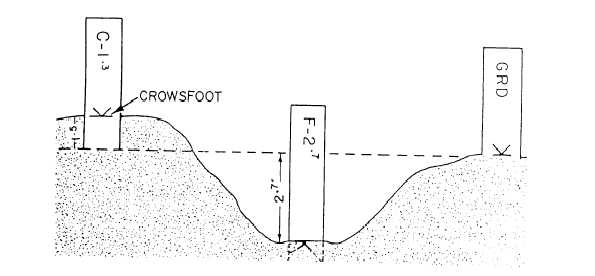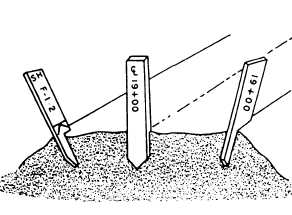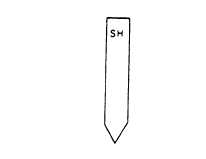Shoulder Stakes
Stakes that are set on a line parallel (same
direction and interval) with the center line are called
shoulder stakes and are identified by the symbol SH
at the top of the stake
Shoulder stakes
shoulders and are set
(fig. 15-28).
mark the outer edge of the
with the broad side facing the
center line of the road on the shoulder line. Shoulder
stakes carry the same station number as the centerline
stake they are set to, but the station number is placed
on the back of the stake (the side facing away from
the center line). The amount of cut or fill is marked on
the side of the shoulder stake facing the center line
(front) and represents the amount of cut or fill required
at that location. The horizontal distance from the
shoulder stake to the center line is sometimes placed
beneath the cut-or-fill figure. The basic difference
between centerline stakes marked with the ~ symbol
and shoulder stakes marked SH is ( 1 ) centerline stakes
are set along the center line of the project and
(2) shoulder stakes are set parallel with the center line
defining the shoulder of the road or runway and face
the center line (fig. 15-29).
Cut-and-Fill Stakes
Figure 15-28.—Shoulder stake symbol.
Figure 15-29.—Center line and shoulder stakes.
Lowering the elevation of a grade is known as
making a cut. Cut stakes are designated by the letter
C written on the stake. The numerals, following the
letter C, indicate the amount of ground to be cut to
obtain the desired grade and are measured from the
crowfoot down.
Raising the elevation of the ground is known as
making a fill. A fill stake is designated by the letter F
written on the stake. The numerals that follow the
letter F indicate the amount of ground material needed
to bring the existing ground to the desired grade and
are measured from the crowfoot mark on the stake up.
In going from a cut to a fill or vice versa, there
may be one or more stakes representing points on the
Figure 15-30.—Cut, fill, and on-grade stakes.
15-18






